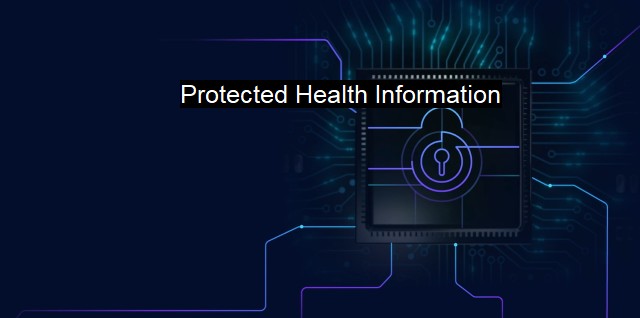What is Protected Health Information?
The Importance of Protected Health Information (PHI) and Cybersecurity Measures Towards Its Protection in Modern Healthcare
Protected Health Information (PHI) is a term that encompasses any information from a patient’s medical records or payment history that can be used to identify an individual. This term is used within the context of the United States health care industry, and is a significant facet of regulations laid out under the Health Insurance Portability and Accountability Act (HIPAA).PHI includes information about a patient's physical or mental health, any care they have received, or payments made for treatments. It is information which is created, used, or disclosed in providing health care services like diagnosis or treatment, and can be in any form – electronic, physical, or verbal.
The security of PHI is paramount in an era increasingly keyed into cyber activity. Within this context, understanding PHI, its use and circulation become more vital than ever. It's why cybersecurity has converged into this area, integrating with health care operations to maintain and secure PHI's integrity.
Data breaches have become a steady worry with accelerating digitalization enforcing a double-edged sword of accessibility and vulnerability. PHI is extremely valuable in the dark market because it can be used for identity theft, insurance fraud, and even extortion. This information, unguarded, represents an enticing prospect for cybercriminals, making health care entities prime targets for cyberattacks.
In 2020 alone, the number of healthcare data breaches increased by 55% compared to the previous year, affecting over 26 million people in the United States. This significantly underlines not just the importance, but the absolute necessity for robust cybersecurity measures within the health care industry. The field though, is one of unique challenges. The data that needs to be protected is sensitive, requiring swift, secure access for ongoing treatments.
The fast-paced nature of health care services demands that data be easily accessible across multiple devices, networks, and platforms. this seamless accessibility is precisely what increases the risks associated with PHI's protection. Cybersecurity therefore operates in protective and restorative parameters, continually innovating measures to ensure an uncompromised defense against an increasingly sophisticated threat panorama. It incorporates approaches which amalgamate policy, technology, information and risk management, and compliance.
Companies are tasked with providing cybersecurity measures to protect PHI, primarily through antivirus programs. An antivirus serves as the first line of defense against malicious activities in a network or system. These programs have evolved significantly to accommodate new modes of threat, handling anything from harmful software like viruses, Trojans, worms, to spyware and ransomware.
The protection of sensitive information such as PHI includes several layers - with antivirus guarding checkpoints of a network or system. The antivirus allows scrutiny of every bit of data entering or leaving, investing in prevention as the ultimate remedy. It accomplishes this through a wide array of methods such as virus databases, heuristics, and sandboxing.
Maintaining the securities and integrities of Protected Health Information has become an industry imperative. It now draws upon comprehensive protocols, an artery of which is cybersecurity and its evaluative tool – the antivirus. In turn, these safeguard procedures serve the spirit of laws like HIPAA, bringing healthcare systems ever closer to a shared goal - fostering a safe, secure digital space for the flow of sensitive patient care data. Ensuring the protection of PHI is not just about obeying the laws and rules; it's also about maintaining trust and loyalty with patients, and continually cementing protocols as we brave a future increasingly navigated in codes.

Protected Health Information FAQs
What is protected health information (PHI)?
Protected health information (PHI) refers to any personal, identifiable health information that is created, received, transmitted, or maintained by a covered entity subject to the Health Insurance Portability and Accountability Act (HIPAA). PHI includes data such as medical records, billing information, insurance information, and any other information that can be used to identify an individual.What are some examples of PHI?
Examples of PHI include medical records, lab results, x-rays, prescription history, and any other health-related information that identifies an individual. It may also include information such as a person's name, address, social security number, or date of birth if it is related to their health information.What measures can be taken to protect PHI?
To protect PHI, covered entities should implement strong cybersecurity measures such as firewalls, encryption, and access controls. Regularly updating software and operating systems can also prevent vulnerabilities that could be exploited by cybercriminals. It is also essential to train employees on how to handle PHI and to have clear policies and procedures in place for data breaches or incidents involving PHI.What are the consequences of a PHI data breach?
Data breaches involving PHI can have severe consequences, including loss of reputation, financial penalties, and legal action. Covered entities may be subject to fines from regulatory bodies such as the Department of Health and Human Services, and affected individuals may seek damages through private lawsuits. In addition to financial consequences, a PHI data breach can also result in a loss of trust from patients and clients, which can be challenging to regain.| | A | | | B | | | C | | | D | | | E | | | F | | | G | | | H | | | I | | | J | | | K | | | L | | | M | |
| | N | | | O | | | P | | | Q | | | R | | | S | | | T | | | U | | | V | | | W | | | X | | | Y | | | Z | |
| | 1 | | | 2 | | | 3 | | | 4 | | | 7 | | | 8 | | |||||||